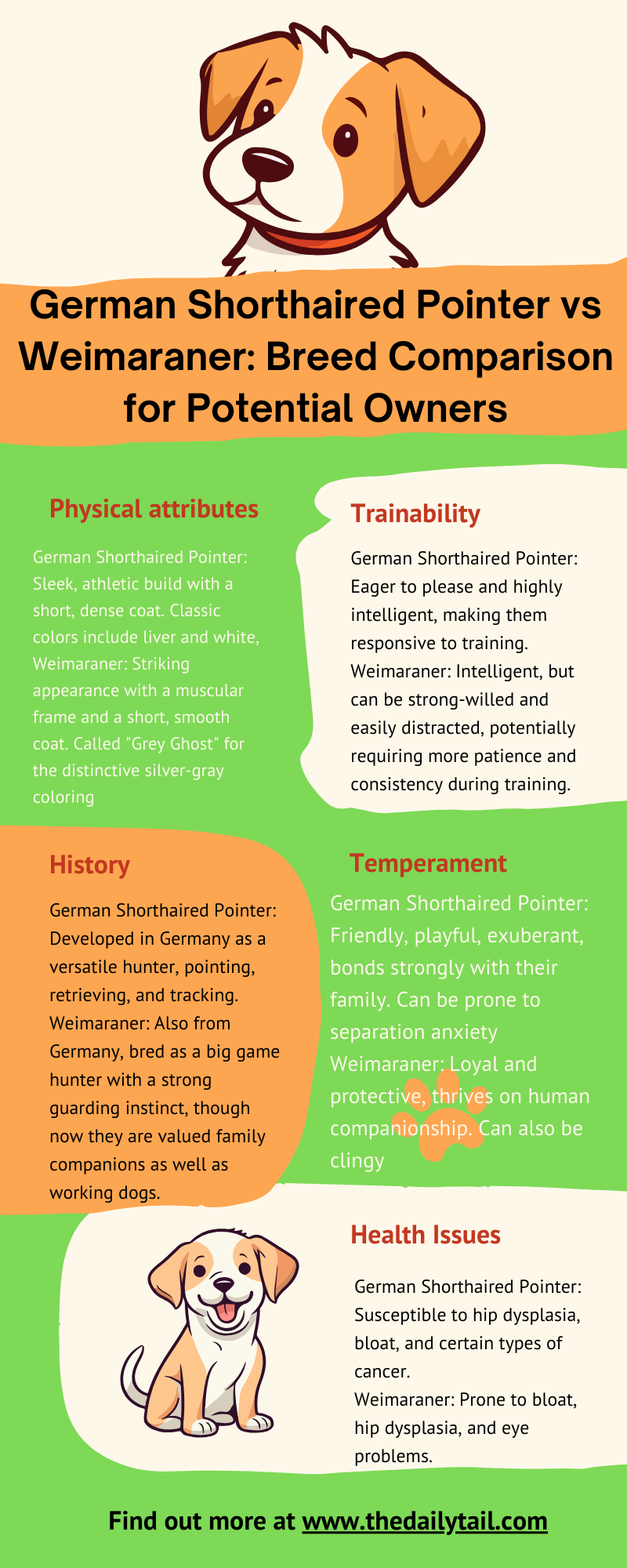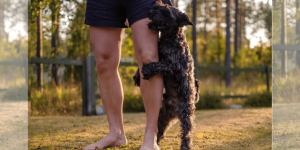Choosing the right dog breed for you and your family can be an exciting yet complex decision, particularly when considering breeds as similar and capable as the German Shorthaired Pointer and the Weimaraner. Both breeds hail from Germany and have been bred for their prowess in hunting, boasting high energy levels and an intense prey drive. Their histories are steeped in active roles, where they have served as all-purpose gundogs, skilled in pointing, retrieving, and hunting a variety of game.
The German Shorthaired Pointer is a versatile hunter and all-around working dog, known for being both a friendly companion and a serious worker. They often have a coat that is brown and white, with variations that include solid, piebald, or roan patterns. Recognizable by their lean frames, they offer agility and speed in the field. Despite their working background, German Shorthaired Pointers are known for being good choices for new dog owners due to their trainable nature and adaptability.
The Weimaraner, sometimes referred to as the “Grey Ghost” due to their distinctive silver-gray coat, is similarly athletic and has a slightly larger build. They can stand up to 27 inches tall and weigh as much as 90 pounds, presenting a picture of grace and stamina combined. Weimaraners are well suited to active families, as they require plenty of exercise and mental stimulation.
Their focused and affectionate temperament makes them a beloved pet, though they can be more challenging for first-time dog owners due to their strong will and high energy levels.
As a lifelong dog lover, I believe the perfect breed is out there for everyone. If you’ve fallen for the athleticism and intelligence of pointing breeds, let’s explore whether the German Shorthaired Pointer or the Weimaraner is your ultimate canine companion.
Origins and History
The German Shorthaired Pointer and the Weimaraner both boast Germanic roots with historical significance in hunting. Their legacies are marked by the development from diverse working breeds to become esteemed hunters and companions.
German Shorthaired Pointer Origins
The German Shorthaired Pointer (GSP) originated in Germany in the 19th century. This breed was meticulously developed for hunting, combining the traits of tracking and pointing breeds such as the Spanish Pointer, English Pointer, and the Bloodhound.
Key points about the GSP origins include:
- Country of Origin: Germany
- Century of Development: 19th century
- Primary Purpose: Versatile hunting dog
- Ancestral Breeds: Spanish Pointer, English Pointer, Bloodhound
Weimaraner History
The Weimaraner has a similar lineage as a hunting breed from Germany. Developed in the 19th century, they were initially bred for nobility to hunt large game such as boar, bear, and deer. Over time, their role shifted to hunting smaller game as the need for large game hunting diminished.
Key points about Weimaraner history include:
- Country of Origin: Germany
- Century of Development: 19th century
- Initial Game Targets: Boar, bear, and deer
- Transition: From large game to smaller game hunting companions
Breed Characteristics
When comparing German Shorthaired Pointers and Weimaraners, distinct differences emerge in terms of size, weight, and coat characteristics. Both are robust working breeds with unique features that reflect their historical use in hunting and their adaptability to various environments.
Size and Weight
German Shorthaired Pointers typically stand between 23 to 25 inches tall at the shoulder for males, and 21 to 23 inches for females. They weigh in at about 55 to 70 pounds for males, and 45 to 60 pounds for females. Weimaraners are slightly larger, with males ranging from 25 to 27 inches and females from 23 to 25 inches. Male Weimaraners weigh between 70 to 90 pounds, and females range from 55 to 75 pounds.
Coat and Colors
The coat of a German Shorthaired Pointer is short and thick, designed to provide protection in rough undergrowth. Its coat color can be solid liver or a combination of liver and white which may include spots and ticking. Weimaraners, on the other hand, have a distinctive short coat that is smooth to the touch and comes in shades ranging from mouse-gray to silver-gray, commonly known as blue-gray. Both breeds have coats that are easy to groom, requiring only regular brushing to remove loose hair and maintain a healthy shine.
Temperament and Personality
When comparing the temperaments of the German Shorthaired Pointer (GSP) and the Weimaraner, it is essential to consider their distinct traits and behaviors that make them unique. Both breeds exhibit intelligence and energy, but their personalities cater to different lifestyles and preferences of dog owners.
German Shorthaired Pointer Traits
The German Shorthaired Pointer is known for being intelligent, energetic, and affectionate. They are often friendly and eager to please, making them excellent companions. GSPs thrive when given tasks and are quick to learn, demonstrating their intelligent and trainable nature. They show a blend of:
- Loyalty: forming strong bonds with their owners
- Energetic disposition: requiring ample exercise
- Friendly demeanor: making them suitable for families
These dogs are also characterized by their loving and affectionate interactions with their human counterparts. However, without sufficient mental and physical stimulation, they might exhibit stubborn behavior.
Weimaraner Behavior
In contrast, the Weimaraner tends to be independent and bold, alongside being intelligent and loving. They are affectionately known as the ‘Gray Ghost’ due to their unique coat and often shadow their owners, indicating their loyal streak. Their notable traits include:
- Boldness: fearless and steady, yet not aggressive
- Affectionate nature: forming deep bonds with their family
- High energy levels: needing rigorous daily exercise
Weimaraners are less friendly with strangers and other dogs than GSPs, potentially displaying an independent streak. Their intelligence can sometimes tilt towards stubbornness if they are not engaged in activities that challenge them mentally and physically.
Exercise and Energy Levels
Both the German Shorthaired Pointer and the Weimaraner are breeds with high energy levels, necessitating substantial exercise to maintain their health and happiness. These dogs are notably active and possess strong stamina, making them ideal companions for outdoorsy and active families.
Physical Activity Recommendations
German Shorthaired Pointers (GSP) generally require at least 3 hours of exercise per day to satisfy their high energy levels and prevent restlessness or destructive behavior. They excel in activities such as running, swimming, and fetch, due to their strong hunting instincts and high prey drive.
Weimaraners, on the other hand, need around 2 or more hours of physical activity daily. While they share similar high prey drives and stamina with GSPs, their exercise requirements are slightly less intense but still substantial. Activities like hiking, agility training, or playing in a fenced yard are great ways to burn their energy.
Mental Stimulation Needs
For mental health and overall wellbeing, mental stimulation is essential for both breeds to complement their physical exercise regimen.
German Shorthaired Pointers benefit from puzzle toys, scent games, and advanced obedience training to engage their intelligent minds. Without adequate mental stimulation, they may find less desirable ways to entertain themselves.
Likewise, Weimaraners require consistent mental engagement. Training them in obedience and giving them tasks to complete can be effective ways to keep their minds sharp. They appreciate interactivity and challenges that cater to their intelligent nature.
Training and Intelligence
When it comes to the German Shorthaired Pointer (GSP) and the Weimaraner, both breeds exhibit high levels of intelligence and trainability, which can be honed through consistent and structured training sessions. They have strong instincts and excel in various dog sports, including agility and tracking.
Trainability and Learning
The GSP is known for being enthusiastic and hard-working when it comes to training. Their intelligence makes them highly trainable, and they often excel in rally, obedience, and tracking. German Shorthaired Pointers have been bred with a strong prey drive, which should be channeled through proper training.
- Learning Speed: German Shorthaired Pointers learn commands quickly
- Prey Drive: High; requires training to manage
The Weimaraner is intelligent but may also display a degree of stubbornness. However, with a patient and consistent training approach, they are highly capable and perform well in agility and obedience tests.
- Learning Speed: Weimaraners are quick learners but may question commands
- Prey Drive: Considerable; training is crucial to manage this trait
Obedience and Agility
Obedience is a strong suit for German Shorthaired Pointers due to their desire to please and work alongside their handlers. They often show a remarkable ability in obedience trials and are eager to please which contributes to their success.
- Obedience: High; GSPs are keen to follow instructions
- Agility: Excellent; they display great athleticism and dexterity
Weimaraners are similarly capable in agility, leveraging their long legs and endurance. They benefit from early socialization and obedience training to curb their independent nature, which can sometimes interfere with training.
- Obedience: Moderate to high; early and consistent training recommended
- Agility: Very good; naturally athletic with a good build for the sport
In both breeds, their intelligence means they may become bored with repetitive tasks, so trainers should keep sessions engaging and varied to maintain interest and focus.
Health and Care
When discussing the health and care of the German Shorthaired Pointer and the Weimaraner, prospective owners should be aware of some breed-specific health issues and understand their grooming and maintenance needs to ensure these active dogs lead a healthy life.
Common Health Issues
Both the German Shorthaired Pointer (GSP) and the Weimaraner are generally healthy breeds with a lifespan of 10-12 years. However, they can be prone to certain inherited conditions that owners should monitor for. Hip dysplasia, a malformation of the hip joint, and elbow dysplasia are common in both breeds, which can lead to arthritis or lameness if not addressed. Checking for these issues regularly is essential, and a veterinarian can provide guidance on monitoring and care.
A condition known as bloat, or gastric dilatation-volvulus (GDV), can also impact these breeds. This critical health problem occurs when the stomach fills with gas and twists. Recognizing the early signs and obtaining immediate veterinary care is crucial for survival.
Both breeds can suffer from hypothyroidism, a disorder where the thyroid gland does not produce enough thyroid hormone, leading to symptoms like weight gain and lethargy. Regular veterinarian check-ups can help in early detection and treatment.
Health Problems Table:
| Health Issue | German Shorthaired Pointer | Weimaraner |
|---|---|---|
| Hip Dysplasia | Common | Common |
| Elbow Dysplasia | Prevalent | Prevalent |
| Bloat (GDV) | Risk Factor | Risk Factor |
| Hypothyroidism | Less Common | Less Common |
| Shedding | Moderate | Moderate |
| Exercise Needs | High | High |
Grooming and Maintenance
Grooming needs for both the GSP and the Weimaraner are moderate. These dogs have short, dense coats that shed. Regular brushing, at least once a week, can help control the shedding and keep their coats clean and shiny. Bathing should be done as needed, but not too frequently, to maintain the natural oils of their skin and coat.
Nails should be trimmed regularly to avoid overgrowth and splitting, which can be painful and lead to problems walking. Dental care is also important—teeth should be brushed regularly to prevent dental disease.
With regard to diet, both breeds benefit from high-quality food that suits their active lifestyle. An appropriate diet can also support joint health, which is particularly important in preventing and managing conditions like hip and elbow dysplasia.
Exercise is crucial for both the GSP and Weimaraner. They require significant daily physical activity—not only to keep fit, but also to stave off boredom and destructive behaviors. Mental stimulation is equally important, as it helps in keeping their intelligent minds engaged. Consulting with a veterinarian will ensure that the care they receive is tailored to their specific needs, which can help keep these active dogs in their best condition.
Compatibility with Families
When considering the German Shorthaired Pointer and the Weimaraner as family pets, their friendly natures and affectionate behaviors towards their human families are of great importance. These breeds typically interact well with children and adapt to living spaces if proper exercise is provided.
Children and Other Pets
German Shorthaired Pointers are known for being good-natured and patient with children, making them an excellent family dog. They are generally friendly towards other pets, especially if socialized from a young age. However, due to their strong prey drive, interactions with small animals such as cats should be supervised.
- Weimaraners, similarly, display a friendly attitude towards kids and can be great companions for them, but their large size and high energy levels call for supervision to ensure play remains safe
- Both breeds may chase cats or other small animals, given their hunting lineage; hence, cautious introduction and socialization are needed for a harmonious household
Adaptability to Living Spaces
German Shorthaired Pointers and Weimaraners can adapt to various living environments, including apartments, as long as they receive adequate exercise.
- Exercise Needs: A minimum of one hour of vigorous activity per day
- Outdoor Space: A securely fenced yard is beneficial but not necessary
Both breeds do best with a family that can offer them activity and companionship. They are not well-suited to being left alone for long periods, as they may become anxious and display unwanted behaviors. It’s pivotal for potential owners to ensure they can meet the exercise and attention needs of these active and sociable dogs.
Hunting and Working Abilities
Both the German Shorthaired Pointer and the Weimaraner excel in hunting and working tasks thanks to their exceptional field competencies and adequate guarding capabilities.
Field Competencies
The German Shorthaired Pointer (GSP) and the Weimaraner are renowned for their prowess in the field. Their hunting abilities stem from a strong prey drive and keen senses. This is particularly evident in their pointing skills, where they excel at identifying the location of prey with remarkable accuracy. With a nose for tracking, they are persistent and alert hunting dogs, able to follow a scent with precision and determination.
- Nose: Both breeds have highly sensitive noses, ideal for tracking
- Prey Drive: High prey drive makes them determined hunters
- Pointing: Exceptional at pointing to indicate the location of prey
Guarding and Protection
While not traditionally categorized as guard dogs, the GSP and Weimaraner can demonstrate protective behaviors. Their alertness makes them suitable for watching over their territory and providing an initial line of defense against intruders.
- Alertness: Both breeds are attentive and will notify their handlers of unusual activity
Overall, both the German Shorthaired Pointer and the Weimaraner bring versatility to hunting and working roles. With appropriate training, they can be dependable companions in various field activities.
Breed-Specific Considerations
When comparing the German Shorthaired Pointer and the Weimaraner, prospective owners should consider the unique behavioral tendencies and physical attribute sensitivities of each breed. These factors are crucial in understanding how each breed may fit into a home environment and what care requirements they come with.
Behavioral Tendencies
German Shorthaired Pointer:
- Barking: They have a moderate tendency to bark, which can be curbed with proper training
- Separation Anxiety: Prone to separation anxiety; they prefer being in the company of their owners
- With Strangers: Typically friendly with strangers but can be reserved without socialization
- Suitable for: Highly suitable for active families due to their need for vigorous exercise
- Chasing: A strong prey drive means they are likely to chase after small animals
Weimaraner:
- Barking: They are known to be vocal, especially when they want attention or exercise
- Separation Anxiety: High risk of separation anxiety, may resort to destructive behavior when left alone
- With Strangers: Can be aloof with strangers and require early socialization to foster sociability
- Suitable for: Best for active individuals or families who can engage them in plenty of exercises
- Chasing: Have a high prey drive and may exhibit a strong desire to chase











